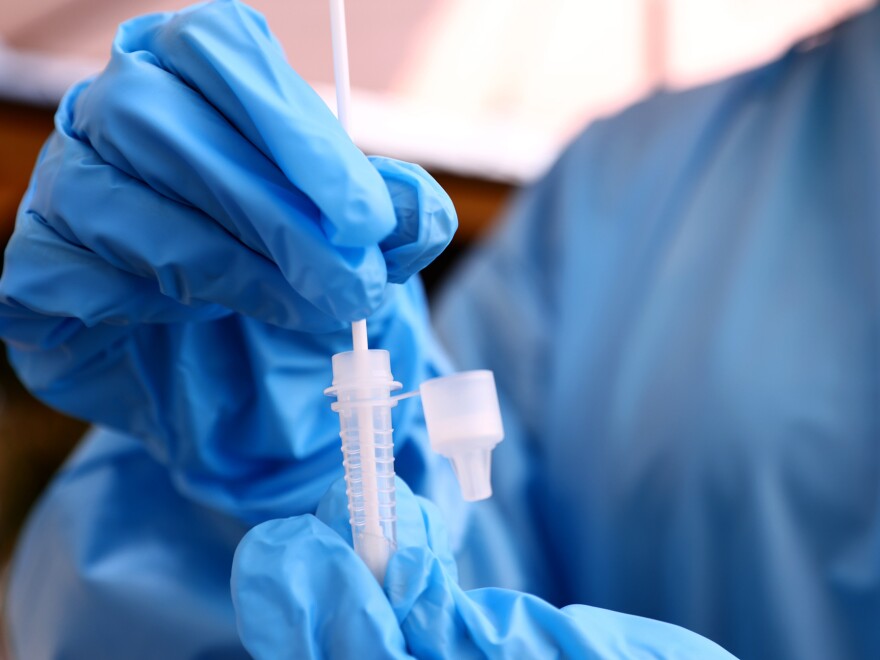There's a lot we need to learn — and fast — about the omicron variant. Federal health officials have been scrambling since Thanksgiving to gather critical information to inform the U.S. response.
Key to that is ramping up the country's capacity to detect the variant in the U.S. population. Once it starts to show up around the country — and experts are confident that's a matter of when not if — tracking its spread will be crucial.
"All of the key questions about the variant are really dependent on us being able to identify the variant here in the U.S. but also tracking how it's spreading and in whom," says Dr. Ashish Jha, dean of the Brown School of Public Health.
But Jha and other experts are concerned that the U.S. capacity to track the variant is limited by a few big issues that have plagued our pandemic response from day one, including the patchwork, siloed nature of our public health capabilities.
"There's a reason we haven't heard of something called the United States variant, and it's not because it doesn't exist. It's because we just don't detect these things early," says Dr. Kavita Patel, a non-resident fellow at the Brookings Institution and physician practicing in Washington, D.C. "They're picked up in other places that tend to have better surveillance systems."
During a briefing Tuesday, Rochelle Walensky, director of the Centers for Disease Control and Prevention, defended the agency's efforts to expand efforts to spot and track new variants.
"Throughout the pandemic... CDC has continuously monitored variants and vastly expanded our capacity for genomic sequencing over the past nine months," Walensky said, noting that the U.S. is now sequencing more than 80,000 specimens of the virus each week, representing one out of every seven that test positive.
"We are actively putting systems in place with local and state laboratories to make detection and sequencing even faster," Walensky said, adding that the U.S. is increasing testing at four major airports: New York, Newark, San Francisco and Atlanta
Here are several areas where public health experts see opportunities to improve U.S. surveillance in the short and longer term.
Take advantage of PCR testing, which can sometimes identify the variant
The CDC is asking labs around the country to step up what they're doing to try to track the variant. The good news is, certain PCR tests can spot likely omicron cases.
"One of the things about this variant is that there is a tell in laboratory tests, so you don't even have to do the full genetic sequencing," says Dr. David Kessler, chief science officer for the federal COVID-19 response. There's a kind of signature — called S gene target failure — that some tests can pick up. In those cases "there is an ability to do an early, quick analysis," Kessler adds, and then prioritize those tests for genetic sequencing.
About 56 state public health labs around the country are currently able to do this, and other labs with the capacity to are being asked to shift to using this test for the next two weeks, according to Scott Becker, chief executive officer of the Association of Public Health Laboratories.
Jha cautions, it's vital that labs start looking for this signal. "Most labs don't look at that automatically," he says. "But that information is in the labs that are doing regular testing, and we've got to be sending the word out that they need to look for that and they need to report that to state health departments and the CDC."
Ramp up genomic sequencing
To definitively pinpoint a case of omicron requires detailed genetic sequencing. This is increasing around the U.S., according to Kessler. "We've ramped up our genetic sequencing markedly, close to 10,000 sequences a day," he says.
Several public health experts think it's not enough. "I think the U.S. has the capability to do much better," says Rick Bright, CEO of the Pandemic Prevention Institute at the Rockefeller Foundation. "They need to make a decision now to ramp up their sequencing capabilities and their genomic surveillance capabilities and do much more testing."
The problem, Bright explains, is that the sequencing that is currently happening may not be well distributed geographically and could easily miss a case in a region with little surveillance.
"If you're focusing on that sequencing in very limited or few populations, you can get 10,000 sequences a day from New York City and doesn't tell you what's happening in the rest of the country," he says.
During Tuesday's briefing, however, Walensky said the agency had received specimens from all 50 states, plus Guam, Northern Mariana Islands, Puerto Rico and the Virgin Islands and the District of Columbia.
"We're sequencing samples from these jurisdictions and from geographically diverse areas around the country, collaborating with state labs and academia and industry partners, and our variant surveillance system has demonstrated we can reliably detect new variants," she said
But Association of Public Health Laboratories CEO Becker agrees that the U.S. could be doing more sequencing.
"In areas of the country where there's less testing going on, you're going to see less specimens coming through the surveillance system and therefore we won't be sequencing as many from those parts of the country," he says. "It's important that all states work with CDC to conduct the surveillance and ramp it up if necessary."
Increase and speed up PCR testing
It appears that PCR and antigen tests still work as well to catch positive cases of the new variant, as they did with older variants, though the FDA is analyzing them to confirm that, says Becker. But the trouble is, note Patel and Bright, the U.S. doesn't do enough testing, and lab turnaround times are slow.
"We need to do much more testing to be able to identify where this virus is in the United States," says Bright. He says one obstacle is that the over-the-counter antigen tests are too unaffordable for many families. "Most Americans don't have access to those tests," he says. "In many places, they're $25 for a kit of two. So we're already behind the gun right there in making sure that more people are able to test rapidly to see if they're infected and should go to further sequencing."
Patel says the U.S. should emphasize testing and shift resources toward "really high throughput PCR testing," since PCR tests can then be sent for genetic sequencing. She notes that there is money from the CARES Act to support testing that has gone unspent.
Improve communication between CDC, state labs, academic labs and clinicians
Even if more labs do more tests, including the type of PCR test that can spot omicron, detection could still be slow because these labs have to start routinely notifying the CDC about what they're finding.
The "silos of our public health surveillance system" have kept the U.S. behind when it comes to detecting variants throughout the pandemic, says the Brookings Institution's Patel.
"The labs that the states run or the labs that the academic centers run are in isolation of where clinical work is happening. So the two just don't speak," she says.
Bright agrees. "We have a lot of capability and different public health labs across the United States, but we're not fully leveraging all of the sequencing capability in our academic sectors and our private sectors, and we're not yet linking all of that together to get as much information as possible," he says.
Start tracking all breakthroughs
An increase in breakthrough infections would be one of the first red flags that the omicron variant is spreading widely in this country and evading the protection offered by the vaccine, says Kessler.
"If in fact it does come into the United States, I would predict that we would see an increase in breakthrough cases," he says, though more breakthrough cases doesn't necessarily mean more severe cases. "That's still up in the air."
Many public health experts say the CDC made a big mistake when it decided to only closely track those breakthrough infections that cause serious illness and deaths, instead of tracking all mild breakthrough cases.
"I think that left us a little bit flat footed. It leaves us now playing catch up," says Patel, explaining that we could have learned more about who was getting breakthroughs and why.
The CDC does track breakthroughs in a limited way, using "cohorts" that Kessler says offer "highly reliable" data, but the most complete data only relates to hospitalizations and death.
Bright says that means, "we're missing the opportunity to look at the changes in those viruses that could be leading to those severe cases and stopping it before it gets there."
"There's a lot of information being left on the table by not looking into those cases," he adds.
Will Stone contributed to this report.
Copyright 2021 NPR. To see more, visit https://www.npr.org.




